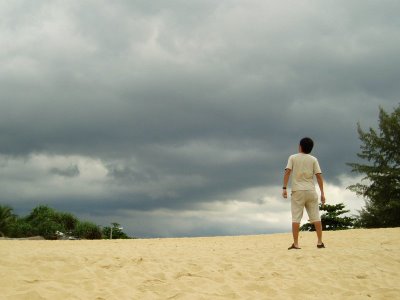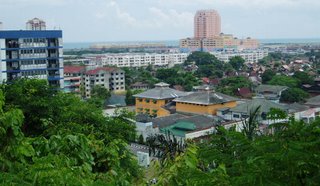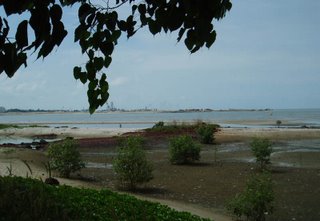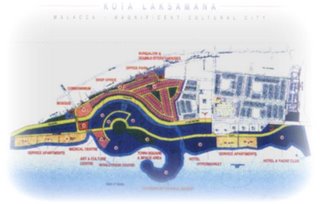Mute and salted

He smiled. His fine teeth seemed bleached against his dark skin, dark as the chengal boards cladding the shops on the side streets of Kuala Besut.
“My ah-kong’s ah-kong’s ah-kong’s ah-kong… That’s how long we’ve been here,” replied Chengal Dude lightheartedly in Mandarin, a language I’m alien. He seemed to be in his early 30s, well-toned, chiseled, sharp-eyed. He was maybe a guide, a pro-diver at Perhentian Islands, we couldn’t tell.
Names, existing terms, fail to describe the man. You may say he is Chinese as I am, but the seasons under the salted sun of Terengganu has bronzed him to the point anyone would mistake him for a Malay.
You may say Chengal Dude is a peranakan of the East Coast, a people less publicized than the Baba-Nyonyas of Melaka or Penang, but no less present. They’ve been around this place for a long time. Chengal Dude is unmistakably a true son of the land, speaks the loghat without ponder or pause, reads the Malay papers, wears the mannerisms of the locals to the subtlest levels. That’s because this culture is his culture; his people contributed to it no less. The Hokkien he shares with the coffeeshop owner is so thick with its own inflections and phrases – a loghat in its own right – you’d miss what was being said. Chengal Dude is Sino-Malay-Siam-Javanese forged by the monsoon winds, ground by the fine sand of its beaches.
There is yet an appropriate name to describe all this.
Records about early settlements in the East Coast are relatively thin, still more fuzzy than pinpoint. Its people are believed to have migrated from Indochina and southern China but the prevailing culture today stems from Java. There are accounts of the expansive kingdom of Langkasuka which reigned in the Isthmus of Kra. Excerpts from a 5th century Chinese script makes reference to a place called Ho-Lo-Tan where a thriving settlement existed.
Who were these people? More importantly, who are they now? There is a very high chance integration occurred on a fairly large scale, a mongrel breed that evades current definitions of race. They are a monsoon tribe who rightfully pwn this land. This time of the year, their sky is blue and their breeze fresh and still unsullied by the corporate pheromones of Guess?, MNG nor Nike.
This is a piscean landscape. They dig fish here. Fish - fresh or seawater - is eaten whole, diced, sliced, fillet, fried, boiled, satayed, grilled. It is processed into a dozen different types of keropok – keropok losong, keropok lekor – and this wonderful conical lump of fish paste called satah. At Kota Bahru’s central market, your eyes pop at the variety of fish sauce available.
And even as we marvel at the cultural peculiarities, the language, the muara settlements, the pregnant storm clouds, the shape of roofs, the friendlier eyes, we learn to draw lessons seldom discussed in west coast circles.

Here again is a lesser-told story of mainland Malaysia – the role of geography in shaping culture. The Titiwangsa Range, rumbling like a dragon from the Ismuth of Kra, wedges the peninsular flatlands apart, creating a jungle curtain practically impenetrable until recently that the East and the West coasts of mainland Malaysia culturally evolved on parallel paths.
If the west coast was about Sumatra and SriVijaya and the Melaka Sultanate, the east was Java and Majapahit and Siam. (Besut, for instance, is a Thai derivative which means Land of Far Away) This gets increasingly evident as one travels northwards along the east coast.
For this was where colonial influence was least – hence less tempered – again thanks to the physical barriers of Titiwangsa. The Portuguese and Dutch waived it, the British had only a token presence, thinning out as the main mountain range thickened up north. The east coast states of Kelantan, Terengganu and Pahang are today a living resource of how things operated without the economic allure of the Straits and tradewinds and without the open-house policy of the British East India that was concentrated more on the west.
The land did not experience the full impact of the population boom, nor the divide-and-rule politics until recently. Rather like a gang of moored perahus, it bobbed and rolled along a slower, more organic development pattern.

Current terms fail to capture what one senses. Rumah doesn’t capture the essence of an east coast dwelling, it sounds wrong; waktu senja is too flaccid for the raging coastal sunset, pasir is ridiculously out of place. Perhaps it’s just personal, but I dare say much of our local Malay nouns evoke a Straits-Sumatran sheen. I feel like a mute.
Malaya, now Malaysia, is a country defined and shaped by the British colonists, just as India and Burma. There is geographical wholeness to it although the region of Sabah and Sarawak is clearly based on political allegiance rather than geology. Within our shores are pockets and folds of cultural dialects each unique to its geography and history. The east coast is but one. As the country rifles through the 21st century, it is our task to nourish and sustain these diverse patterns that exist in the many enclaves.
Pray Putrajaya has the wisdom to opt away from a mono-Malaysia. The east coast – like Sabah and Sarawak, like hill towns and coastal towns, like muara towns and hulu kampongs – has to be allowed the faith to grow in its own imagination, locked genuinely to its current patterns and practices.
If a west coast Bandar boy would take the trouble to see, he would see a lot. Yeo and I did that. On the Buddhist holiest full moon of Wesak, a period revering Gautama’s search and eventual understanding, we too set on a search and came out understanding a little more about our land and who we are.
We entered from the drylands of Jelebu – onto the riverine settlements of Temerloh, onto Kuantan and Kuala Terengganu and Kota Bahru, through lemang land, keropok coasts, and nira fields, through the oil refineries of Kerteh, into the womb of the Penarik lagoon, kissed the shoulder of the Thai-Malaysian border – and emerged through the very, very wet rain scoop that is the East-West Highway.

In that little pilgrimage we are reaffirmed that our land is beautiful, yet raised from a viewpoint heavily slanted towards the west, we are clipped in tongue to describe its being. In a land where elements of Malay, Java, south China, and Indochina are pounded on a monsoon pestle, marinated with the spice of time, we can only taste so well its flavour but not describe it with due justice. Our language falls short.
Chengal Dude doesn’t fret.
“Oh, Ko’lompor…” he mutters when we tell him where we’re from, makes a smirk on his lips and a slight shrug of his shoulders. In not so many words, it said – Orang Bandar, you who seek escalators and aircon, perched in 30-storey tiled concrete boxes, wear jackets and gowns to dinners, jump to synthesized beats and throbbing lights, of course, you’re mute.
P.S. For material that speak more than a thousand words, pls see http://www.aiyeo.net/?p=64






